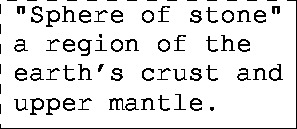

Learn about the different types of rock formations with these printable geology flash cards.
There are 30 flash cards in this set (5 pages to print.)
To use:
1. Print out the cards.
2. Cut along the dashed lines.
3. Fold along the solid lines.
Sample flash cards in this set:




| Questions | Answers |
|---|---|
| Lithosphere | "Sphere of stone" a region of the earth's crust and upper mantle. |
| Plates | Several "floats" like rafts on the plastic rock of the upper mantle. |
| Pangaea | (Hypothesis) all the continents were connected together into one huge land mass |
| Fault | Fracture zone - at the boundary between stationary rock and moving rock. |
| 3 major kinds of faults | 1. Normal Fault - occurs when rocks along one side of fault sink vertically. 2. Strike-slip fault - when rocks along one side move horizontally. 3. Thrust Fault - when rocks on one side of a fault are shoved on top the other side. |
| Fold | Bending or buckling of rocks under great force |
| Syncline | Troughlike structure caused from rocks that bend downward during the folding process |
| Anticline | Archlike structure formed from rocks that buckle upward during folding |
| Volcanic Mountain | Molten rock erupts from a hole in the earth's crust |
| Folded Mountain | Formed when edges of two adjacent rock layers were pushed together |
| Domed Mountain | When molten rock is forced beneath an overlying rock layer |
| Fault-block Mountain | Formed along a fault; the rocks on one side are forced upward while the other side sink |
| Tectonic Earthquakes | Earthquakes that result from sudden movements of rock beneath the earth's surface |
| Tremor | Weak earthquake |
| Tsunamis | Giant sea waves |
| Aftershocks | Smaller earthquakes or tremors that follow a major earthquake |
| seismology | Study of earthquakes |
| Focus | The point at which an earthquake begins |
| Epicenter | The point on the earth's surface directly above the focus |
| Seismograph | An instrument that records the vibrations caused by an earthquake |
| Seismogram | Record produced by seismograph |
| Circum-Pacific Belt | Most active zone for earthquakes |
| Richter Magnitude Scale | Scale used to measure earthquake strength |
| Volcano | An opening in the earths structure through which hoy gases, ash, and molten rock are ejected from earths interior |
| Volcanology | The study of volcanoes |
| Dormant | Asleep, inactive |
| Ring of fire | Narrow zone of active volcanoes that parallels the circumference. Pacific Belt: more than half the Earth's active volcanoes here |
| Caldera | Huge bowl-shaped craters |
| Dike | Verticle, sheetlike mass of igneous rock |
| Sill | Horizontal, sheetlike mass of igneous rock |